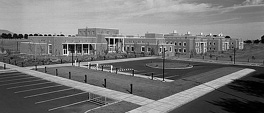Path forward
Madia tells managers that feedback will be a key component in forming the ‘Laboratory Agenda’
About 500 Laboratory managers made a trip to town on June 13 for ORNL Director Bill Madia’s first “senior staff” meeting of managers. Because of the size of the crowd, the meeting was held in the Oak Ridge High School auditorium.The leadership team, however, is aiming for an even larger audience. Madia plans to conduct these managers’ meetings several times a year. They are one step in a process to keep ORNL staff members apprised of the leadership team’s vision for the Lab, which they acknowledge is still developing. Managers were tasked to return to their groups and fill them in on what was discussed at the meeting and to give the leadership team direct feedback on resulting comments and ideas.
The leadership team will use that feedback as it evolves what Madia termed the “Laboratory Agenda.” Referring to the Lab’s “path forward,” Madia touched on a number of subjects during the briefing.
For instance, Madia told the group that ORNL’s recovery from a projected $9 million budget shortfall was “slightly ahead of the plan.” Initiatives that were adopted in May have already saved $3.5 million of the total. Madia said that if the Lab continues at that pace, the shortfall would be made up by October, the end of the fiscal year.
To avoid future surprises, Chief Financial Officer Greg Turner is “putting in place better management controls” of the Lab’s business system. “We need a lot of simplification in this area, and that’s our intent,” Madia said.
The Spallation Neutron Source has a strong leadership team in place, he said. The project has hired 150 people in the past year and has received the blessing of some of its most vocal critics. Favorable reviews and the addition of the Jefferson Lab to contribute to a superconducting linear accelerator were other bright points. Challenges the SNS must overcome include the House Appropriations Committee’s $100 million markup for the project, well shy of the President’s $287 million request.
ORNL now has a preliminary design for its facilities revitalization initiative, which is based on traditional DOE line-item funding, $26 million in state funding for four new facilities and—the most innovative facet—private-sector development funding. Madia and the leadership team have acknowledged all along that federal funding to support, in total, a building program of the scope planned for ORNL is unlikely.
“Other people’s money is necessary,” Madia said. The director expressed pleasure with the support the Lab has received from DOE, “especially ORO,” for third-party financing for new Lab facilities. He added that buildings in the 6000 and 4500 areas are also slated for refurbishment.
Madia’s vision for the Lab, in addition to new facilities, includes more competitive cost structure and salaries. A “rather serious cost reduction program” is planned for later this year. “We want to take ORNL from its current place among the most expensive labs to a more competitive position among the lowest third,” he said. At the same time, researcher salaries are on average 10 to 15 percent below the market. Madia said measures were being taken to close the gap.
Many of the aforementioned topics play directly into the development and implementation of the Laboratory Agenda, which will, Madia said, serve as a blueprint for ORNL’s future.
ORNL’s path forward, Madia said, is organized around “simultaneous excellence” in science and technology, operations and ES&H and community service. These objectives, he said, include strategic objectives, critical outcomes, Lab-level initiatives and tactical actions.
Progress with the SNS and the facilities upgrade initiative were cited as key examples of the path forward through the Laboratory Agenda. They are elements, Madia said, that are strategically important to ORNL’s future, require teamwork to accomplish and figure highly in DOE’s evaluation of both ORNL’s and the leadership team’s performance.
| ORNL 1.95 | The cost-reduction goal is to get the Lab’s composite multiplier rate, which tops this list of nine labs, into the bottom third. |
| PPPL 1.92 | |
| LLNL 1.83 | |
| PNNL 1.80 | |
| BNL 1.75 | |
| SNL 1.74 | |
| ANL 1.67 | |
| NREL 1.66 | |
| LBNL 1.56 | |
 |
|
Science and technology goals include the SNS, establishment of a center of excellence in complex biological systems, establishment of a high-performance computing lab, leadership in carbon management and clean energy and sustained leadership in materials science.
Operations and ES&H goals include the new campus and to “be known for delivering maximum R&D per dollar spent.” Progress will be measured by a number called the “composite multiplier rate.” That’s the metric in which ORNL currently tops a list that includes eight other national labs. The Lab’s goal is to get the number, currently at 1.95, closer to the lowest third of lab rates, which bottom out at 1.56.
In the community service arena, ORNL, as a “good corporate citizen,” intends to strenghthen science and math education and to be a major player in the region’s economic development. About half of the $1.25 million in corporate giving set aside annually by UT-Battelle will go to economic development initiatives and another third of that sum will go to education, primarily science and math.
UT-Battelle will also have to arrive at a long-term strategy for ensuring the viability of the American Museum of Science and Energy, which is currently under ORNL’s purview but not funded by the Department.
Madia repeatedly returned to the “path forward” theme during a question and answer session after his prepared remarks. When queried about SNS use of ORNL services, Madia and Deputy Director for Operations Jeff Smith reminded the audience that SNS, although not mandated to use ORNL services, buys “a plethora” of Lab services. “But they want as much independence as they can have to get the job done,” said Madia.
Added Smith: “It’s an interesting dynamic. If the Lab can provide a high-value service, so be it. The up side for us is what’s a good deal for Dave (SNS Executive Director David Moncton) is a good deal for us.”
When asked about the possibility of staff cuts in ORNL’s future, Madia could not rule them out.
“We decided not to fix our overhead shortfall with staff cuts, but it could happen,” he said. “Nobody’s off limits. You tell us where the high-value activity is and where the low-value activity is.”
However, he also remarked that, in addition to an aging facility, ORNL also has an aging staff, and the inflow of new talent is “at a trickle.” ORNL’s agenda, he said, is to build the Lab and maximize research dollars.
“Remember,” he reminded the group, “the main issue is that our costs are too high.”—B.C.
 |
| Pacific Northwest’s Environmental Molecular Sciences Laboratory |
| Pacific Northwest: ‘New’ is a relative term |
| The most-cited example of outside financing for new Lab facilities is Pacific Northwest National Laboratory, the Battelle-operated multiprogram lab in Richland, Wash. ORNL Reporter recently visited PNNL for a meeting of public affairs staff from most of the labs.
The first impression one gets of PNNL is that of an oasis. Richland gets only eight inches of rain a year. Yet stately sycamores and maples line the boundaries of the lab; the grass is perfect. And sprinkler heads are as common there as dandelions are in East Tennessee. The main administration building—the Research Operations Building—is a striking complex of buildings with a plaza and a pool festooned with fountains. It makes the impression that this must be the type of spanking new facility we’re aiming for. Everything, in fact, looks nice and new. Offices are well-lit and clean. But the Environmental Molecular Sciences Laboratory is PNNL’s showpiece. As PNNL’s new user facility, it has a spacious lobby and sitting area, a well-furnished conference room and laboratory space galore. EMSL Deputy Director Doug Ray comments that he visited ORNL’s High Temperature Materials Laboratory recently and it reminded him of the EMSL. Sure enough, they are similar, although EMSL’s architecture is more traditional and it seems much larger— and newer by more than a decade. It opened in 1997. The Hanford site in itself is vast, with its nine reactor sites spaced out along miles of desert beside the Columbia River. In the outback you’ll find the cleanup sites—the most massive in the DOE system—and older facilities that better reflect the site’s wartime origins. But things don’t have to look like World War II forever, and PNNL reflects Bill Madia’s contention that a place that does first-rate science ought to look the part. That nice, new Research Operations Building, for instance. Or so I thought, until our host pointed at it and, rather dismissingly, said, “This is the first building Battelle built at Pacific Northwest, in 1965.”—B.C. |

